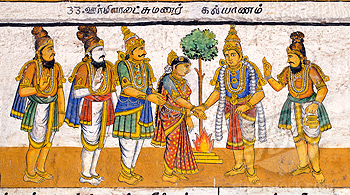|
Ashram
An ashram (, ) is a spiritual hermitage or a monastery in Indian religions, not including Buddhism. Etymology The Sanskrit noun is a thematic nominal derivative from the root 'toil' (< PIE *''ßĖ▒remh2'', ┼øramaß╣ća) with the prefix 'towards.' An ashram is a place where one strives towards a goal in a disciplined manner. Such a goal could be ascetic, spiritual, yogic or any other. Overview [...More Info...] [...Related Items...] OR: [Wikipedia] [Google] [Baidu] |
Sevagram Ashram
Sevagram (meaning "A town for/of service") is a town in the state of Maharashtra, India. It was the place of Mahatma Gandhi's ashram and his residence from 1936 to his death in 1948. After Sabarmati, Sevagram Ashram holds immense importance due to the residence of Mahatma Gandhi. Overview Sevagram, originally Segaon, is a small village, located about 8 km from Wardha. Gandhi set up what eventually became an ashram in the outskirts of the village. Seth Jamnalal Bajaj of Wardha, a disciple of Gandhi, made available to the ashram about 300 acres (1.2 km2) of land. Near the ashram there is a museum where artifacts of India's freedom struggle are preserved. History When Gandhi started his padayatra (foot march) in 1930 from Sabarmati Ashram to Dandi for the Salt Satyagraha, he decided not to return to Sabarmati till India achieved independence. Gandhi was imprisoned for more than two years. On his release he spent some time travelling around India. He decided to ... [...More Info...] [...Related Items...] OR: [Wikipedia] [Google] [Baidu] |
Vishvamitra
Vishvamitra (, ) is one of the most venerated rishis or sages of ancient India. Vishvamitra is one of the seven Brahmarshi. According to Hindu tradition, he is stated to have written most of the Mandala 3 of the Rigveda, including the Gayatri Mantra (3.62.10). The Puranas mention that only 24 rishis since antiquity have understood the whole meaning of ŌĆöand thus wielded the whole power of ŌĆö the Gayatri Mantra. Vishvamitra is supposed to have been the first, and Yajnavalkya the last. Before renouncing his kingdom and royal status, Brahmarishi Vishvamitra was a king, and thus he retained the title of Rajarshi, or 'royal sage'. Textual background Historically, Vi┼øv─ümitra G─üthina was a Rigvedic rishi who was the chief author of Mandala 3 of the Rigveda. Vi┼øv─ümitra was taught by Jamadagni Bh─ürgava. He was the purohita of the Bharata tribal king Sud─üs, until he was replaced by Vasiß╣Żß╣Łha. He aided the Bharatas in crossing the Vip─ü┼øa and ┼Üutudr─½ rivers (mod ... [...More Info...] [...Related Items...] OR: [Wikipedia] [Google] [Baidu] |
Hermitage (religious Retreat)
A hermitage most authentically refers to a place where a hermit lives in seclusion from the world, or a building or settlement where a person or a group of people lived religiously, in seclusion. Particularly as a name or part of the name of properties its meaning is often imprecise, harking to a distant period of local history, components of the building material, or recalling any former sanctuary or holy place. Secondary churches or establishments run from a monastery were often called "hermitages". In the 18th century, some owners of English country houses adorned their gardens with a "hermitage", sometimes a Gothic ruin, but sometimes, as at Painshill Park, a romantic hut which a "hermit" was recruited to occupy. The so-called Ermita de San Pelayo y San Isidoro is the ruins of a Romanesque church of Ávila, Spain, that ended up several hundred miles away, to feature in the Buen Retiro Park in Madrid. Western Christian tradition A hermitage is any type of domestic dwelli ... [...More Info...] [...Related Items...] OR: [Wikipedia] [Google] [Baidu] |
Lok Biradari Prakalp
Lok Biradari Prakalp (LBP) (Marathi; Brotherhood of People project) is a social project of the ''Maharogi Sewa Samiti'', Warora involving a hospital, a school and an animal orphanage. It was started on 23 December 1973, by the social worker Baba Amte for integrated development of Madia Gond. It is in Hemalkasa, Bhamragad taluka in Gadchiroli District of Maharashtra, India. Dr. Prakash Amte and his wife Dr. Mandakini Amte, who serve as the medical director and medical officer at the project respectively, were awarded the 2008 Ramon Magsaysay Award for Community Leadership. Davakhana Davakhana means clinic in Marathi. In this project, primary health care has been given top priority. Six sub-centres were started in the interior forest area, geographically wide apart from the main hospital; three are still functional. The early years of the project entailed a massive struggle in the difficult conditions of a thick and remote forest. The centre, started in 1973, has recent ... [...More Info...] [...Related Items...] OR: [Wikipedia] [Google] [Baidu] |
┼øramaß╣ća
A ''┼øramaß╣ća''; ; ; ; ) is a person "who labours, toils, or exerts themselves for some higher or religious purpose" or "seeker, or ascetic, one who performs acts of austerity".Monier Monier-Williams, ÓżČÓźŹÓż░Óż«ÓżŻ ┼øramaß╣ća, Sanskrit-English Dictionary, Oxford University Press, p. 1096 The ┼øramaß╣ća tradition includes primarily Jainism, Buddhism, and others such as the ─Ćj─½vika. The ┼øramaß╣ća religions became popular in the circles of mendicants from greater Magadha that led to the development of spiritual practices, as well as the popular concepts in all major Indian religions such as '' saß╣ās─üra'' (the cycle of birth and death) and ''moksha'' (liberation from that cycle).Flood, Gavin. Olivelle, Patrick. 2003. ''The Blackwell Companion to Hinduism.'' Malden: Blackwell. pp. 273ŌĆō274. The ┼Üramaß╣ćic traditions have a diverse range of beliefs, ranging from accepting or denying the concept of Soul, fatalism to free will, idealization of extreme asceticism to that of ... [...More Info...] [...Related Items...] OR: [Wikipedia] [Google] [Baidu] |
Shakuntala Plaque From Bhita
Shakuntala () is a heroine in ancient Indian literature, best known for her portrayal in the ancient Sanskrit play '' Abhijnanashakuntalam'' (The Recognition of Shakuntala), written by the classical poet Kalidasa in the 4th or 5th century AD. Her story, however, originates in the Hindu epic, the ''Mahabharata'' (c. 400 BC - 400 AD), where she appears in the ''Adi Parva'' ("The Book of Beginnings"). In both narratives, Shakuntala is the daughter of the sage Vishwamitra and the celestial nymph Menaka. Abandoned at birth, she is raised by the sage Kanva in a forest hermitage. She later falls in love with King Dushyanta and becomes the mother of Bharata, a celebrated emperor of India. In the ''Mahabharata'', Shakuntala and Dushyanta secretly get married through the gandharva tradition (love marriage) and consummate their marriage in her forest hermitage. When she later approaches him with their son Bharata, he hesitates to acknowledge them. Shakuntala rebukes him forcefully ... [...More Info...] [...Related Items...] OR: [Wikipedia] [Google] [Baidu] |
Lakshmana
Lakshmana (, ), also known as Laxmana, Lakhan, Saumitra, and Ramanuja, is the younger brother of Rama in the Hindu epic ''Ramayana''. He is considered as an incarnation of Shesha, the lord of serpents. Lakshmana was married to Urmila, and is known for his loyalty and dedication towards Rama. Lakshmana was born to King Dasharatha of Ayodhya and Queen Sumitra. Shatrughna, is his twin brother. He was married to Urmila, after his brother Rama married Sita in her swayamvara. Lakshmana devoted himself to Rama since childhood and accompanied him during his fourteen-year exile, serving him and Sita endlessly. He also played a pivotal role in the war and killed Meghanada. Lakshmana is worshipped in Hinduism, at various places in India, alongside Rama and Sita. Etymology The name Lakshmana is of Sanskrit origin, which means 'the one endowed with auspicious signs'. He bears the epithets of Saumitra (, ) and Ramanuja (, ). Legend Birth and early life King Dasharatha of A ... [...More Info...] [...Related Items...] OR: [Wikipedia] [Google] [Baidu] |
Meditation
Meditation is a practice in which an individual uses a technique to train attention and awareness and detach from reflexive, "discursive thinking", achieving a mentally clear and emotionally calm and stable state, while not judging the meditation process itself. Techniques are broadly classified into focused (or concentrative) and open monitoring methods. Focused methods involve attention to specific objects like breath or mantras, while open monitoring includes mindfulness and awareness of mental events. Meditation is practiced in numerous religious traditions, though it is also practised independently from any religious or spiritual influences for its health benefits. The earliest records of meditation ('' dhyana'') are found in the Upanishads, and meditation plays a salient role in the contemplative repertoire of Jainism, Buddhism and Hinduism. Meditation-like techniques are also known in Judaism, Christianity and Islam, in the context of remembrance of and prayer and dev ... [...More Info...] [...Related Items...] OR: [Wikipedia] [Google] [Baidu] |
Krishna
Krishna (; Sanskrit language, Sanskrit: ÓżĢÓźāÓżĘÓźŹÓżŻ, ) is a major deity in Hinduism. He is worshipped as the eighth avatar of Vishnu and also as the Supreme God (Hinduism), Supreme God in his own right. He is the god of protection, compassion, tenderness, and love; and is widely revered among Hindu divinities. Krishna's birthday is celebrated every year by Hindus on Krishna Janmashtami according to the lunisolar calendar, lunisolar Hindu calendar, which falls in late August or early September of the Gregorian calendar. The anecdotes and narratives of Krishna's life are generally titled as ''Krishna L─½l─ü''. He is a central figure in the ''Mahabharata'', the ''Bhagavata Purana'', the ''Brahma Vaivarta Purana,'' and the ''Bhagavad Gita'', and is mentioned in many Hindu philosophy, Hindu philosophical, Hindu theology, theological, and Hindu mythology, mythological texts. They portray him in various perspectives: as a god-child, a prankster, a model lover, a divine hero, ... [...More Info...] [...Related Items...] OR: [Wikipedia] [Google] [Baidu] |
Rama
Rama (; , , ) is a major deity in Hinduism. He is worshipped as the seventh and one of the most popular avatars of Vishnu. In Rama-centric Hindu traditions, he is considered the Supreme Being. Also considered as the ideal man (''mary─üda'' ''puruß╣Żottama''), Rama is the male protagonist of the Hindu epic '' Ramayana''. His birth is celebrated every year on Rama Navami, which falls on the ninth day of the bright half ( Shukla Paksha) of the lunar cycle of Chaitra (MarchŌĆōApril), the first month in the Hindu calendar. According to the ''Ramayana'', Rama was born to Dasaratha and his first wife Kausalya in Ayodhya, the capital of the Kingdom of Kosala. His siblings included Lakshmana, Bharata, and Shatrughna. He married Sita. Born in a royal family, Rama's life is described in the Hindu texts as one challenged by unexpected changes, such as an exile into impoverished and difficult circumstances, and challenges of ethical questions and moral dilemmas. The most not ... [...More Info...] [...Related Items...] OR: [Wikipedia] [Google] [Baidu] |
Monastery
A monastery is a building or complex of buildings comprising the domestic quarters and workplaces of Monasticism, monastics, monks or nuns, whether living in Cenobitic monasticism, communities or alone (hermits). A monastery generally includes a place reserved for prayer which may be a chapel, Church (building), church, or temple, and may also serve as an Oratory (worship), oratory, or in the case of Cenobium, communities anything from a single building housing only one senior and two or three junior monks or nuns, to vast complexes and estates housing tens or hundreds. A monastery complex typically comprises a number of buildings which include a church, dormitory, cloister, refectory, library, Wiktionary:balneary, balneary and Hospital, infirmary and outlying Monastic grange, granges. Depending on the location, the monastic order and the occupation of its inhabitants, the complex may also include a wide range of buildings that facilitate self-sufficiency and service to the commun ... [...More Info...] [...Related Items...] OR: [Wikipedia] [Google] [Baidu] |
Ayodhya (Ramayana)
Ayodhya is a city mentioned in the ancient Sanskrit-language texts, including the ''Ramayana'' and the ''Mahabharata''. These texts describe it as the capital of the Ikshvaku kings, including Rama. The historicity of this legendary city is of concern to the Ayodhya dispute. According to one theory, it is same as the present-day Indian city of Ayodhya. According to another theory, it is a fictional city, and the present-day Ayodhya (originally called S─ük─ōta) was renamed after it around the 4th or 5th century, during the Gupta period. Scriptural references According to the ''Ramayana'', Ayodhya was founded by Manu, the progenitor of mankind, and measured 12x3 '' yojanas'' in area. Both the ''Ramayana'' and the ''Mahabharata'' describe Ayodhya as the capital of the Ikshvaku dynasty of Kosala, including Rama and Dasharatha. The ''Purana-pancha-lakshana'' also describes the city as the capital of Ikshvaku kings, including Harishchandra. The ''Ramayana'' states that t ... [...More Info...] [...Related Items...] OR: [Wikipedia] [Google] [Baidu] |









